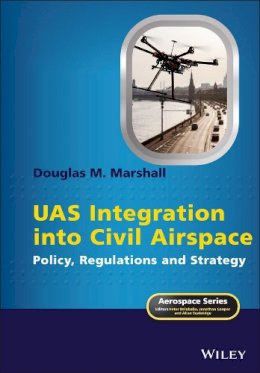
UAS Integration into Civil Airspace
Douglas M. Marshall
Explores current Unmanned Air Systems policies with a view to developing a common airspace access and integration strategy
UAS Integration into Civil Airspace: Policy, Regulations and Strategy examines the current state of Unmanned Aerial Systems (UAS) airspace access and integration around the world, focusing on the efforts that have produced a regulatory response to the demand for access. This analysis discusses the proposed architectures for a common strategic and analytical thread that may serve as templates for the entire community, as well as for regulators and policymakers who must balance the needs and demands of UAS users with the general public’s right to safe skies and privacy. An understanding of the market forces and business cases that are fuelling the development of the technology is also covered with a focus on the economics of the industry.
The book presents a strategy for airspace access and integration that will facilitate humanitarian, environmental, social and security uses of unmanned aircraft systems on a global scale.
Key features:
- Discusses existing and evolving policies and regulations from nations around the world for operating Unmanned Aerial Systems (UAS) in civil airspace
- Examines the current status of technological developments such as UTM and U-space and explores the technological potential in the years to come
- Presents a comprehensive airspace integration strategy that balances the many conflicting interests in the UAS world, with due regard for safety, utility and affordability
UAS Integration into Civil Airspace: Policy, Regulations and Strategy is essential reading for all professionals involved in UAS industry, as well as students in mechanical engineering and law.
Product Details
About Douglas M. Marshall
Reviews for UAS Integration into Civil Airspace
Patrick Egan, sUAS News The book is easy to read, refreshingly so for such a complex subject and is accessible to all readers, even without a detailed technical knowledge. It is a useful reference for everyone in the industry, including regulators who will inevitably determine the pace of adoption of UAS in civil airspace. Most of the world’s aviation authorities, service providers and regulators have engaged in intense efforts since the early 2000s to establish methods and safety protocols to integrate UAS into complex and increasingly busy controlled and uncontrolled airspace. This book provides an excellent oversight of international progress, along with ICAO’s oversight and direction of co-ordinating rules and, in my view is the ‘go-to’ book for UAS operations and by far the best introduction on the subject available to date.
Richard Deakin, FRAeS, AEROSPACE
